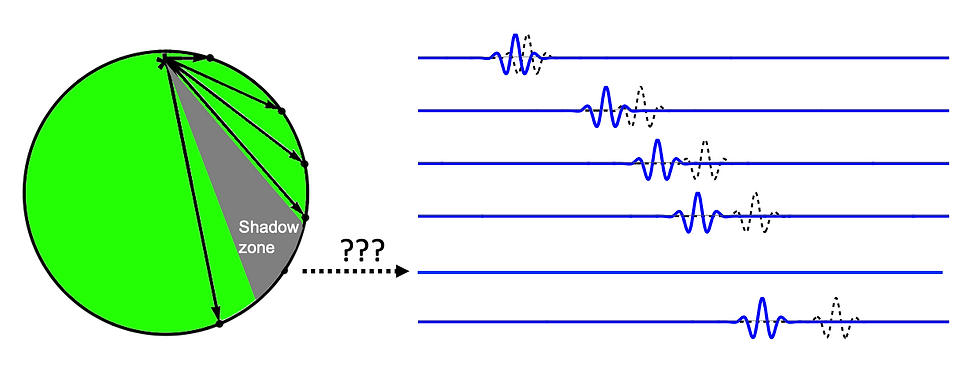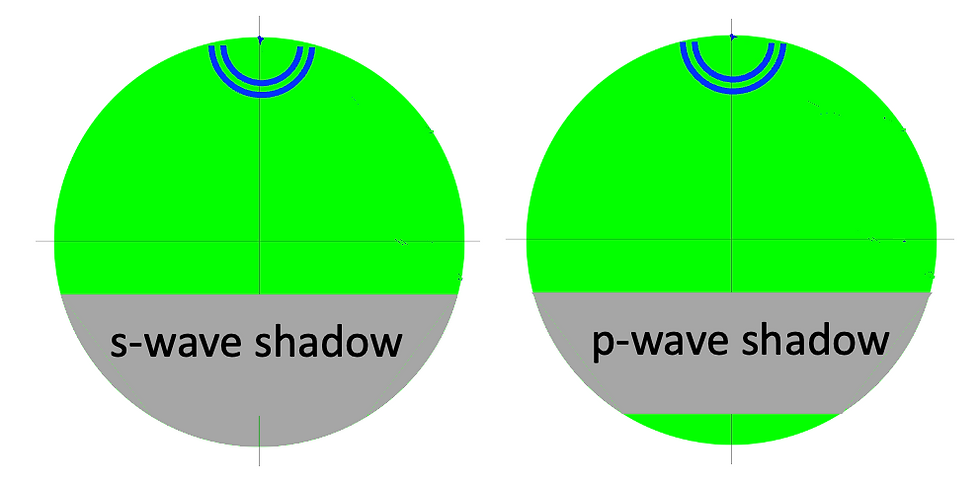The upside of earthquakes
- brianaull
- Jan 21
- 4 min read
Updated: Jun 19

Earthquakes are destructive but they have a beneficial side effect. The seismic waves created by quakes travel both along the Earth's surface and through its interior and are detected by seismometers at many places around the world. The waves that go through the Earth's interior give us the geological equivalent of a brain scan. We can discover a lot about the interior structure of the Earth without the inconvenience of digging a 4000-mile-deep hole.
"X-raying" the Earth
Here's a video showing a seismic wave emanating from an epicenter (*) and being recorded sequentially by six seismometers at increasing distances away. Right now we're looking only at a particular kind of wave, known as a p-wave, that travels faster than the other kinds. The more distant the seismometer, the longer it takes for the p-wave to get there. What does this pattern of delay times tell us about the Earth's interior? If the Earth were just solid rock and the speed of the waves were the same everywhere, things would be simple. The wave reaching each seismometer would have traveled there along a straight line path from the epicenter, shown below as rays. Divide the length of each ray by the corresponding delay time to get the wave velocity. All seismometer locations should give the same answer.

But they don't give the same answer. The waves reaching more distant seismometers arrive earlier than expected from looking at the closest ones. This suggests that the waves that go deeper into the Earth go faster. A second interesting feature is that p-waves are not detected in what's called the shadow zone, which goes from 103 degrees to 150 degrees away from the epicenter. Beyond the shadow zone, p-wave detections reappear.

There's another type of wave, known as an s-wave, that travels slower than a p-wave. It shows the same pattern of deeper waves going faster. The shadow zone, however, does not stop at 150 degrees. No s-waves are observed for any angle beyond 103 degrees.
What is going on here?
Veering into the fast lane
Study of the arrival times at the closer seismometers reveal a gradation of wave speed. As one goes deeper, the waves travel faster. This is because the pressure increases as one goes deeper. This intensifies the forces between atoms, which in turn propels the seismic waves to move faster. This speed gradation causes the waves to travel along a curved path, as illustrated in the video below. Essentially, this is refraction, but in a graded region rather than at an abrupt boundary.
Here's an illustration of refraction along two paths through the Earth. Each curved path is longer than the straight path, but takes less time because it is veering into a region of faster wave velocity.

What's casting the shadow?
The figure below shows in green the areas that are "illuminated" by seismic s-waves and p-waves emanating from a quake at the top, and in gray the areas that are not, that is, the shadows. Why the shadows and why are they different for s-waves and p-waves?

First let's look at the difference between s-waves and p-waves, illustrated below. The p-wave (top) has regions of expansion and compression along the direction of wave motion. The compression is resisted by strong repulsive forces between atoms. These strong forces propel the wave at high speed, although if the material is made of heavy atoms, this will slow the wave down.
The s-wave (bottom) is an undulation perpendicular to the direction of wave motion. There's no compression. In solid rock, it's just a bending of chemical bonds. Chemical bonds resist being bent, but this is not as strong a force, so the s-waves travel more slowly than p-waves. If the solid liquifies, however, the chemical bonds get broken. So, s-waves won't penetrate into any region where the rock has liquified.

The observation of the shadow zones led to the discovery that the Earth has a solid mantle with a liquid core on the inside. This core blocks the s-waves completely and, being composed of heavier metals, slows down the p-waves. The abrupt change of p-wave velocity at the boundary between the mantle and the core causes refraction; that is, the path of the wave bends, much like a light ray going from air into a glass lens. The s-waves are blocked and the p-waves are partially focused. Here is an illustration:

To learn more
This has been a simplified introduction to the subject of seismology. For example, I left out the complexity added by waves being reflected from the Earth's surface and from the mantle-core boundary. This NSF website has animations, videos, lessons, seismogram viewers and web apps.



Comments